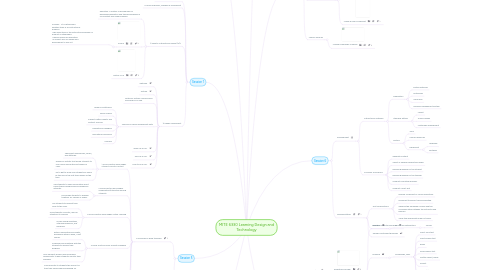
1. Session 1
1.1. *Getting to know each other
1.2. *Course overview, schedule & assessment
1.3. *What is Instructional Design (ID)?
1.3.1. Definition: A system of procedures for developing education and training programs in a consistent and reliable fashion.
1.3.2. ADDIE
1.3.2.1. Analysis: *It is determined whether there is an instructional problem. *The objectives of the instructional program or product is established. *Learner needs are evaluated. *A project plan for design and development is laid out.
1.3.3. History of ID
1.4. *Needs Assessment
1.4.1. Optimals
1.4.2. Actuals
1.4.3. Optimals-Actuals=Performance Discrepancy or Gap
1.4.4. Sources of Needs Assessment data
1.4.4.1. Larger Constituency
1.4.4.2. Policy Makers
1.4.4.3. Subject Matter Experts and Content Sources
1.4.4.4. Educational Managers
1.4.4.5. Educational Deliverers
1.4.4.6. Learners
1.4.5. When do a NA?
1.4.6. Why do a NA?
1.4.7. How to do a NA?
2. Session 3
2.1. Learning Theories
2.1.1. Behaviorism
2.1.1.1. Classical Conditioning
2.1.1.1.1. Phase 1: Before Conditioning
2.1.1.1.2. Phase 2: During Conditioning
2.1.1.1.3. Phase 3: After Conditioning
2.1.1.2. Operant Conditioning
2.1.1.2.1. Neutral Operants
2.1.1.2.2. Reinforcement
2.1.1.2.3. Punishment
2.1.2. Cognitivism
2.1.2.1. Information Processing Model
2.1.2.1.1. Sensory memory
2.1.2.1.2. Short-term memory( working memory)
2.1.2.1.3. Long-term memory
2.1.3. Constructivism
2.1.3.1. Personal/individual constructivism
2.1.3.2. Social constructivism
3. Session 5
3.1. 7 Principles of good teaching
3.1.1. 1.Good Practice Encourages Student-Faculty Contact
3.1.1.1. Share past experiences, values, and attitudes.
3.1.1.2. Design an activity that brings students to your office during the first weeks of class.
3.1.1.3. Try to get to know your students by name by the end of the first three weeks of the term.
3.1.2. 2.Good Practice Encourages Cooperation/interaction among Students
3.1.2.1. Ask students to share information about each other’s backgrounds and academic interests.
3.1.2.2. Encourage students to prepare together for classes or exams.
3.1.3. 3.Good Practice Encourages Active Learning
3.1.3.1. Ask students to present their work to the class.
3.1.3.2. Give students concrete, real life situations to analyze.
3.1.3.3. Model asking questions, listening behaviors, and feedback.
3.1.4. 4.Good Practice Gives Prompt Feedback
3.1.4.1. Return examinations promptly, preferably within a week, if not sooner.
3.1.4.2. Schedule brief meetings with the students to discuss their progress.
3.1.4.3. Give frequent quizzes and homework assignments to help students monitor their progress.
3.1.5. 5.Good Practice Emphasizes Time on Task
3.1.5.1. Communicate to students the amount of time they should spend preparing for class.
3.1.5.2. Expect students to complete their assignments promptly.
3.1.6. 6.Good Practice Communicates High Expectations
3.1.6.1. Publish students’ work on a course website. This often motivates students to higher levels of performance.
3.1.6.2. Be energized and enthusiastic in your interaction with students.
3.1.7. 7.Good Practice Respects Diverse Talents and Ways of Learning
3.1.7.1. Use a range of teaching activities to address a broad spectrum of students.
3.1.7.2. Provide extra material or exercises for students who lack essential background knowledge or skills.
3.2. 5 First Principles of Effective Instruction
3.2.1. The demonstration principle
3.2.2. The application principle
3.2.3. The task-centered principle
3.2.4. The activation principle
3.2.5. The integration principle
4. Session 7
4.1. Web2.0 tools
4.1.1. Wiki
4.1.2. Blog
4.1.3. WebQuest
4.1.4. Google Forms
4.1.5. Delicious
5. Session 2
5.1. Task Analysis
5.1.1. Ways of conducting Task Analysis
5.1.1.1. Convene Expert panel
5.1.1.2. Observation of experts
5.1.1.3. Interview of experts
5.1.1.4. Survey of experts
5.1.1.5. Manuals/Books
5.2. Performance problems
5.2.1. Wile's model
5.2.2. Mager & Pipe's Flowchart
5.3. Learner Analysis
5.3.1. Maslow's hierarchy of needs
6. Session 4
6.1. Learning objectives
6.1.1. ABCD approach
6.1.1.1. A: Audience ( Can be part of the statement)
6.1.1.2. B: Behavior ( Performance)
6.1.1.3. C: Conditions (During Performance)
6.1.1.4. D: Degree ( Criterion, Quality or Standard)
6.2. 9 Events of Instruction
6.2.1. Gaining attention
6.2.1.1. Attention
6.2.2. Informing learner of lesson objective
6.2.2.1. Expectancy
6.2.3. Stimulating recall of prior learning
6.2.3.1. Retrieval to working memory
6.2.4. Presenting stimuli
6.2.4.1. Pattern recognition; selective perception
6.2.5. Guiding learning
6.2.5.1. Chunking, rehearsal, encoding
6.2.6. Eliciting performance
6.2.6.1. Retrieval, responding
6.2.7. Providing informative feedback
6.2.7.1. Reinforcement, error correction
6.2.8. Assessing performance
6.2.8.1. Responding, retention
6.2.9. Enhancing retention and learning transfer
6.2.9.1. Retention, retrieval, generalization
7. Session 6
7.1. Development
7.1.1. Instructional materials
7.1.1.1. Preparation
7.1.1.1.1. Printed materials
7.1.1.1.2. Multimedia
7.1.1.1.3. Visual aids
7.1.1.1.4. Learning Management System
7.1.1.2. Standard setting
7.1.1.2.1. Layout
7.1.1.2.2. Screen design
7.1.1.2.3. Multimedia arrangement
7.1.1.3. Factors
7.1.1.3.1. Time
7.1.1.3.2. Human resources
7.1.1.3.3. Equipment
7.1.2. Common Procedures
7.1.2.1. Generate content
7.1.2.2. Select or develop supporting media
7.1.2.3. Develop guidance for the student
7.1.2.4. Develop guidance for the teacher
7.1.2.5. Conduct formative revisions
7.1.2.6. Conduct a Pilot Test
7.2. Implementation
7.2.1. Pilot Observations
7.2.1.1. Prepare a checklist of course objectives.
7.2.1.2. Document timing of topics presented.
7.2.1.3. Observe the exchange of ideas and the communication between the instructor and learners.
7.2.1.4. Verify the appropriate order of topics.
7.2.2. Periodic Instructor Briefings
7.2.3. Periodic Participant Briefings
8. Session 8
8.1. Evaluation
8.1.1. Kirkpatrick's model
8.1.1.1. Reaction
8.1.1.1.1. "Customer satisfaction"
8.1.1.2. Learning
8.1.1.2.1. Knowledge, Skills
8.1.1.3. Behavior
8.1.1.3.1. Transfer of learning to the real-world
8.1.1.4. Results
8.1.1.4.1. "Bottom line"
8.1.2. Common Procedures
8.1.2.1. Determine evaluation criteria
8.1.2.2. Select evaluation tools
8.1.2.3. Conduct evaluations
8.2. Bloom's Taxonomy
8.2.1. Cognitive
8.2.2. Affective
8.2.2.1. Receiving
8.2.2.2. Responding
8.2.2.3. Valuing
8.2.2.4. Organizing
8.2.2.5. Characterizing
8.2.3. Psychomotor(Simpson, 1972)
8.2.3.1. Perception
8.2.3.2. Set
8.2.3.3. Guided response
8.2.3.4. Mechanism
8.2.3.5. Complex overt response
8.2.3.6. Adaptation
8.2.3.7. Origination
